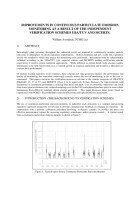Air monitoring
IMPROVEMENTS IN CONTINUOUS PARTICULATE EMISSIONMONITORING AS A RESULT OF THE INDEPENDENT VERIFICATION SCHEMES UBA/TUV AND MCERTS.
Oct 06 2014
Author: William Averdieck on behalf of CEM
1) ABSTRACT
Increasingly plant operators throughout the industrial world are required to continuously monitor particle emissions to atmosphere to satisfy regulatory requirements. Both in Germany and now in the UK, regulators specify the standard to which they expect this monitoring to be performed. Instruments must be independently validated according to the UBA/TUV type approval scheme and MCERTS product certification scheme respectively if used in certain industrial applications. While different in certain detail, both schemes require instruments to be both field tested over a 3-month period in a typical application and tested in a laboratory to evaluate their performance.
Of interest to plant operators in all countries, these schemes not only generally improve the performance and quality of monitoring, but somewhat surprisingly actually reduce the cost of monitoring as far as the user is
concerned. This paper overviews the verification process as relevant to the various categories of UBA/TUV (BImSchV 13, 17 & 27) and MCERTS (Class 1 to 4) approvals. It then discusses the improvements (and limitations) in instrument performance resulting from these standards. Cost of ownership reductions can result from lower plant evaluation costs, reduced sampling costs (in the UK) and reduced purchase price in cases where instruments from different suppliers obtain similar approvals. This paper discusses these issues based on experiences with PCME’s Electrodynamic (rod electrification) and light attenuation instruments.
2) INTRODUCTION (THE BACKGROUND TO VERIFICATION SCHEMES)
The use of continuous particulate emission monitors on industrial stack emissions is a common and growing regulatory approach around the world since it provides instantaneous feedback on changes in emissions. In combination with a periodic calibration procedure involving iso-kinetic samples, it provides the most cost effective measurement regime for assessing regulatory compliance and/or process control. A typical report from a continuous particulate emission monitor is shown in figure 1.
Figure 1. Typical report from a Continuous Particulate Emission Monitor
The performance of continuous particulate monitors is application specific and for optimum application of such instruments one balances the needs for accuracy, reliability, robustness and cost effectiveness. Since in practice, these needs tend to be difficult to combine in the same instrument design, verification schemes are introduced by regulators to help guide users to select instrumentation with the appropriate balance between these characteristics. Both the German UBA/TUV type approval scheme and the relatively new UK MCERTS certification scheme effect the type and performance of particulate monitors used to satisfy regulatory requirements. These verification schemes are also of relevance to regulators and users outside the UK and Germany, since there are no other European verification systems based on instrument performance and the American (US-EPA) requirements for certifying continuous particle monitors are still emerging (reference 1). This paper focuses on the nature of both the UBA/TUV and MCERTS verification schemes and details, with examples, the improvements in monitoring that has and is resulting from their adoption.
Digital Edition
AET Guide 2025
March 2025
Buyer's Guide Directory - Product Listings by Category - Suppliers Listings (A-Z) Air Monitoring - Stack Emissions Multi-Gas Analysis: OFCEAS<sup>®</sup> Technology Seduces the Market...
View all digital editions
Events
Mar 18 2025 Expo Santa Fe, Mexico
Mar 18 2025 Moscow, Russia
Mar 19 2025 Manila, Philippines
Mar 19 2025 New Delhi, India
Mar 20 2025 Guangzhou, China

.jpg)


.jpg)










